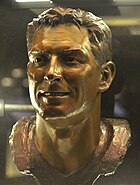Jerry Rice
He won three Super Bowl titles with the San Francisco 49ers before two shorter stints at the end of his career with the Oakland Raiders and Seattle Seahawks.
[8][9][10] His biography on the official Pro Football Hall of Fame website names him "the most prolific wide receiver in NFL history with staggering career totals".
Rice developed connections with quarterbacks Joe Montana and Steve Young that are viewed as among the best in NFL history, helping him lead the league in both receiving yards and touchdowns six times, and in receptions twice.
After recovering from a knee injury and his play regressing, San Francisco released him in June 2001, where the Raiders would sign him to a four-year deal.
[20] During the off-season before his junior year, Rice increased his training; running several miles back to his house because he didn't have a ride.
[24] According to sports journalist Glenn Dickey, Rice caught 50 receptions and 30 touchdowns as a senior, helping to lead the team to a 17–2 record over his final two seasons.
[40] Under the direction of Cooley, Mississippi Valley State ran an "unusual" offense, playing four wide receivers who tended to line up on one side of the field.
[39] After an August practice experiment, Cooley had Totten call all the plays at the line of scrimmage without a huddle, resulting in even more staggering offensive numbers.
that he was unsure about what success he might have in the league, and that he would "often play head games" with himself; his backup plan if his football career didn't pan out was fixing electronics.
[67][68] In training camp, Rice had to compete with 49ers Dwight Clark and Freddie Solomon for roster spots at the wide receiver position.
[78] After a seven reception, 111-yard performance in a 31–16 victory in the regular season finale against the Dallas Cowboys, while scoring a rushing touchdown,[79] CBS announcer Pat Summerall stated that "When this guy [Rice] is finished [retires], he'll be considered one of the greatest wide receivers to ever play this game.
[81] United Press International (UPI) named Rice the NFC Offensive Rookie of the Year, and he was selected to the PFWA All-Rookie Team.
[102][103][104] Rice struggled in the Divisional Round against the eventual Super Bowl-winning Giants, fumbling what would have been a long touchdown on the game's first drive.
[181][182][183] Along with Montana, teammates Ronnie Lott and Roger Craig had left in free agency, making Rice "the last of the Mohicans" as he described himself, the only remaining star player from San Francisco's 80s dynasty.
[200] Overall, Rice finished the season with 84 catches for 1,201 yards and ten touchdowns, and was once again named to the Pro Bowl and First-team All-Pro team.
[204] San Francisco won in the Divisional Round against the Redskins, but lost in the NFC Championship against the eventual Super Bowl champion Dallas Cowboys, being unable to stop the offense of Troy Aikman and Emmitt Smith.
[22][222] These assertions were proven correct, as Rice made it back to the Super Bowl with the 49ers in 1994, recording 112 receptions for 1,499 yards and 13 touchdowns, with Sanders winning the NFL Defensive Player of the Year Award.
After an 87-yard, one-touchdown day to start the season against the New Orleans Saints, Rice had 11 receptions for 167 yards and two touchdowns in a 41–10 victory over the Atlanta Falcons.
[275] During the 49ers' opening game of the season, Rice tore the anterior cruciate and medial collateral ligaments in his left knee on a reverse.
[7] San Francisco still made the postseason with a 13–3 record, beating the Minnesota Vikings in the Divisional Round 38–22, but lost for the third straight time against the Green Bay Packers 23–10 in the NFC Championship.
San Francisco struggled as a whole, going 4–12 and missing the postseason, losing 11 out of their last 12 games after Young had concussion troubles,[294] leading him to retire after the season.
[301][302] With the emergence of Terrell Owens in San Francisco and because of their desire to rebuild the team and clear salary, Rice was released by the 49ers in June 2001 and signed with the Oakland Raiders for a four-year, $7.8 million contract.
[303][304][70] He joined a Raiders team coming off a loss in the playoffs to form one of the oldest receiver duos with Tim Brown (age 35).
[338] Rice played his last non-preseason professional game for Seattle, a Wild Card Round loss to the St. Louis Rams in which he did not catch a pass.
"[363] Stickum and similar adhesives were banned in the NFL in 1981, four years before Rice joined the league; he commented that "all players" in his era used the substance.
[369] He was inducted in Canton, Ohio, on August 7, 2010, alongside Emmitt Smith, Floyd Little, Russ Grimm, Rickey Jackson, Dick LeBeau, and John Randle.
He paired with dancer Anna Trebunskaya, and they reached the final two before losing to singer Drew Lachey and his partner Cheryl Burke.
[405] In 2019, he co-authored a book America's Game: The NFL at 100 (with Randy O. Williams, ISBN 978-0062692900), celebrating the 100th anniversary of the National Football League.
[410] He competed in the Fresh Express Classic at TPC Stonebrae on the Nationwide Tour on April 15–16, 2010, receiving a sponsor's exemption to play in the tournament.
[413][414] After Colin Kaepernick announced that he would be kneeling during the national anthem during games, Rice criticized his actions, stating in a Twitter post: "All lives matter.






